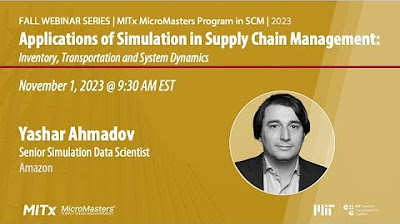Reshaping Business and Supply Chain Strategy Beyond Covid-19 with Professor Yossi Sheffi
Summary
TLDR在这场由麻省理工学院运输与物流中心举办的MicroMasters跨课程直播活动中,Yossi Sheffi教授分享了他对COVID-19大流行期间全球供应链影响的见解。Sheffi教授是供应链韧性领域的专家,他讨论了企业如何应对危机,强调了风险管理的重要性,并提出了供应链恢复的“打地鼠式”模式。他还探讨了技术在供应链中的快速应用,以及媒体对供应链失败的报道与实际情况的差异。此外,Sheffi教授对全球化、不平等、政治民族主义以及假新闻等问题表达了担忧,并对未来供应链管理职业的机遇和挑战提供了洞见。
Takeaways
- 📚 重视供应链风险管理:新冠疫情凸显了供应链风险管理的重要性,公司需要更加关注供应链中的潜在风险和中断。
- 🌐 加强供应链的可见性和透明度:为了快速响应供应链中的突发事件,提高供应链的可见性和透明度变得至关重要。
- 🛑 应对危机时的应急措施:企业应设立应急管理中心,集中处理信息和决策,确保与所有利益相关者的沟通,并明确决策权。
- 🔄 供应链的灵活性和适应性:疫情中企业展现出迅速适应市场变化的能力,如汽车公司转产呼吸机,以及3M增加口罩生产。
- 📈 电子商务的显著增长:由于疫情导致的居家隔离,电子商务和在线销售经历了爆炸性增长,许多实体店铺转向线上销售。
- 🌍 疫情对全球供应链的影响:不同地区和行业的复苏不均衡,导致全球供应链出现“打地鼠式复苏”,即随机的爆发、关闭和重新开放。
- 🛍️ 消费者行为的改变:疫情期间,消费者的购物习惯发生了变化,更多的人选择在线购物,且一部分消费者打算继续这种购物方式。
- 🏭 供应链的地理多元化:企业可能会采取“中国+1”策略,即在中国以外增加投资,以平衡风险并应对潜在的供应链中断。
- 💡 技术在供应链中的新应用:技术在供应链管理中的作用日益增强,特别是在提高供应链的效率和响应能力方面。
- 🌿 可持续性挑战与机遇:尽管疫情给可持续性带来了挑战,但也为推动技术创新和全球合作提供了机遇,可能会成为可持续性发展的转折点。
Q & A
Yossi Sheffi教授在供应链管理方面的主要专长是什么?
-Yossi Sheffi教授是麻省理工学院的长期教授,他在供应链管理的所有领域都是专家,特别是在供应链的韧性方面有深入的研究,并且一直在紧密跟踪COVID-19对供应链的影响。
在COVID-19大流行期间,供应链管理中最大的意外发现是什么?
-Yossi Sheffi教授表示,他并没有特别意外的发现,因为大多数公司在供应链管理方面已经做得很好,尤其是在风险管理和适应性方面。但是,他指出政府在风险管理方面的表现不佳,特别是在医疗物资和个人防护装备的储备和补给方面。
为什么说每个中断都是不同的,但管理中断的方法却大致相同?
-Sheffi教授引用了托尔斯泰的“安娜·卡列尼娜原则”,说明每个家庭的不幸各有不同,但管理大多数风险和中断的方法却大致相同,这包括设置应急管理中心、沟通、决策制定、审查供应商能力和融资等。
在COVID-19期间,供应链的哪些方面表现出了出色的适应性?
-在COVID-19期间,供应链在多个方面表现出了出色的适应性,例如食品供应链在餐馆和机构关闭的情况下,仍然能够满足超市的需求。此外,一些公司迅速转向生产医疗设备和口罩,显示出供应链的灵活性和响应能力。
为什么说COVID-19期间供应链管理的“最佳时刻”?
-Sheffi教授认为,尽管面临前所未有的挑战,供应链在满足需求和适应变化方面表现出色,例如食品供应链成功地将产品从关闭的机构转移到超市,而且大多数情况下没有出现严重的短缺。
在COVID-19大流行期间,哪些行业受到了最大的冲击?
-受到最大冲击的行业包括那些涉及人们聚集的行业,如航空业、酒店业和体育赛事等,因为这些行业在疫情期间受到了严重的限制或关闭。
COVID-19对供应链的长期影响是什么?
-Sheffi教授预测,供应链的长期影响将包括对风险管理和供应链韧性的更大关注,以及对供应链透明度和可见性的更多投资。此外,他提到供应链的角色和重要性已经得到了提升。
为什么说COVID-19可能是供应链管理职业的“正确时机”?
-Sheffi教授认为,由于供应链管理在应对危机中的关键作用,以及未来对供应链专业人士的需求增加,现在进入这一领域的职业是一个好时机。
在COVID-19之后,供应链管理中可能出现哪些新的职业机会?
-预计会出现与供应链风险管理、供应商保证、经济可持续性以及供应链透明度和可见性相关的新职业机会。
Yossi Sheffi教授对于供应链管理专业人士有什么建议?
-Sheffi教授建议供应链管理专业人士阅读更多相关书籍,了解风险管理和供应链管理的知识,并准备好在危机时期应对不确定性。
COVID-19期间,供应链管理中的一个积极变化是什么?
-Sheffi教授指出,供应链管理的角色和重要性得到了提升,供应链管理专业人士现在被视为公司的重要资产,与CEO和其他高层管理团队紧密合作。
为什么说COVID-19大流行可能会成为供应链管理的“拐点”?
-Sheffi教授认为,COVID-19大流行是一个重大的冲击,它将导致公司更加重视供应链的韧性和风险管理,这可能会引发供应链管理方式的长期变化。
在COVID-19之后,供应链管理的趋势是什么?
-Sheffi教授预测,供应链管理的趋势将包括更多的全球化,使用新的技术和方法来提高供应链的透明度和可见性,以及对供应链风险管理的更大关注。
COVID-19对供应链管理专业人士意味着什么?
-对于供应链管理专业人士来说,COVID-19意味着他们的职业变得更加重要和需求增加,同时也需要他们适应新的挑战和变化,如风险管理和供应链的韧性。
Outlines

This section is available to paid users only. Please upgrade to access this part.
Upgrade NowMindmap

This section is available to paid users only. Please upgrade to access this part.
Upgrade NowKeywords

This section is available to paid users only. Please upgrade to access this part.
Upgrade NowHighlights

This section is available to paid users only. Please upgrade to access this part.
Upgrade NowTranscripts

This section is available to paid users only. Please upgrade to access this part.
Upgrade NowBrowse More Related Video

Global Supply Chains: How Did All This Stuff Get Here?

The Critical Role of Supply Chains in Business and Society

Leveraging supply chain optimization and visibility to achieve carbon reduction targets

Supply Chain Risk Management and X shoring

The Magic Conveyor Belt: Supply Chains, A.I., and the Future of Work

Applications of Simulation in Supply Chain Management
5.0 / 5 (0 votes)
